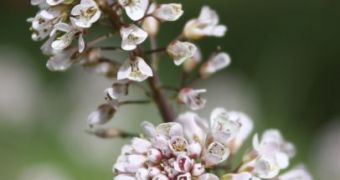Scientists from Oxford University have found that a small wildflower accumulates metal in its leaves as a protection against bacterial infection.
The name of this wildflower is Alpine pennycress (Thlaspi caerulescens), and it is a small plant from the mustard family that grows on metal-rich soils in Britain and Europe.
The flower from the sites of former mine workings accumulates zinc, nickel and cadmium in very high concentrations in its leaves and scientists did not realize this type of “armor” until now.
It was rather difficult to explain why a flower would gather toxic metals in its leaves, but Oxford researchers found that Thlaspi plants were resistant to Pseudomonas syringae pv. Maculicola bacterium attack.
Helen Fones, the graduate student who carried out the experiments, grew Thlaspi plants on different concentrations of zinc, nickel and cadmium and concluded that all three metals were able to defend the plant against the bacterium.
She then studied different strains of Pseudomonas syringae pv. Maculicola, and found the relationship between the capacity of the bacteria to develop in environments with high concentrations of metal and their ability to infect the plants.
Dr Gail Preston of Oxford University’s Department of Plant Sciences, and co-author of the report said that these “results demonstrate that these plants are exploiting their metal-rich environment to armor themselves against disease.”
“What we’ve found is a direct link between these high metal concentrations and resistance to bacterial infection.”
Professor Andrew Smith of Oxford’s Department of Plant Sciences, co-supervisor of the research explained that in the past, “it has been difficult to explain why Thlaspi plants should accumulate such high concentrations of potentially toxic metals.”
“Our findings provide good evidence that, by accumulating metals, these plants benefit from enhanced protection against enemies such as pathogenic microorganisms and herbivores,” he added.
Another conclusion that the researchers drew was that bacteria surviving on Thlaspi plants on the site of a former lead–zinc mine in Wales had a higher tolerance for zinc than bacteria isolated from plants growing on normal soils.
This only means that the plant, as well as the bacteria are able to adapt to metal-rich environments and that pathogens will always find a way of adapting to plants' metal-based defense strategy.
“Heavy metals may be part of an evolutionary ‘arms race’ between plants and the microorganisms that try to colonize them,” Dr Preston said.
The findings were published in the journal PLoS Pathogens.

 14 DAY TRIAL //
14 DAY TRIAL //